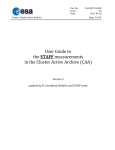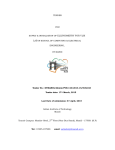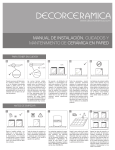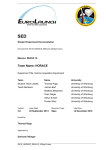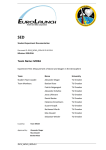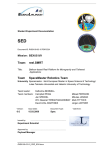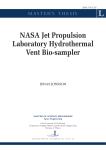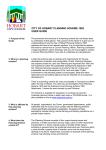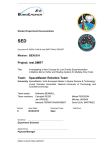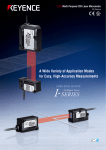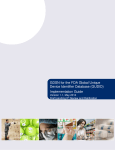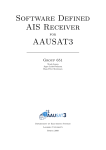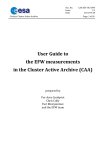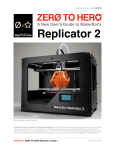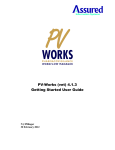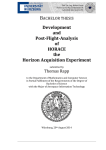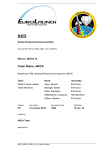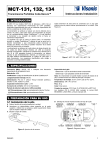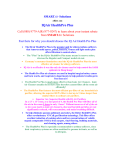Download Documents_files/RXBX CASS-E proposal
Transcript
REXUS / BEXUS 2009/2010 Experiment Proposal Form Full experiment title Cranfield Astrobiological Stratospheric Sampling Experiment (CASS•E) REXUS BEXUS spinning with 4 Hz despun with Yo-Yo to about 0.08 Hz Science & Organisation What is the scientific and / or technical objective of your experiment? This description should outline the scientific / technical question addressed, the assumptions made and the research methods chosen to solve the question. Expected results should be stated. Broad scientific aims: To expand understanding of the nature and limits of life in Earth’s Stratosphere. To improve the understanding of Planetary Protection and Contamination Control (PP&CC) implementation in life detection experiments for stratospheric and broader astrobiology missions. Broad technical aims: To design, build and fly an experiment that is capable of collecting microorganisms in the Earth’s Stratosphere. To ensure that microorganisms collected are truly stratospheric rather than contamination introduced during payload assembly, integration, ground handling, launch, flight and recovery. CASS•E specific experimental objectives: To design, assemble, integrate, ground handle, launch, fly, recover and assess an experiment that is capable of demonstrating appropriate PP&CC protocols relevant to the collection of microorganisms in the Earth’s Stratosphere. To implement appropriate PP&CC protocols for a stratospheric balloon experiment compatible with the collection of microorganisms in or from the Earth’s Stratosphere. To evaluate the performance of the PP&CC protocols used in the stratospheric balloon experiment. Assumptions: There is microbial life in the Earth’s Stratosphere. Concentrations of microbial life in Earth’s Stratosphere are extremely low. Any realistic experiment to sample microbial life from the Earth’s Stratosphere will capture numbers of stratospheric microorganisms that Page 1 of 13 BEXUS EXPERIMENT PROPOSAL FORM 2009/2010 are minute compared to likely levels of microbial contamination from the Troposphere (i.e. contamination during assembly, integration, testing and other ground handling of a sampling experiment/hardware). Research methods: Using previous designs of other sampling experiments as a basis, instrumentation will be designed with PP&CC requirements implemented. The instrument will be designed with the appropriate materials and design features to facilitate efficient decontamination and maintenance of cleanliness during assembly, testing and integration. In addition to this, appropriate measures will be implemented to protect this clean environment during flight, landing and recovery –i.e., bio-barrier. Microbiological techniques will be used to monitor levels of contamination and to validate cleaning and sterilisation procedures throughout the whole development process of the instrument. Two approaches to validate the bio-barriers (valve in inlet port and physical barrier): standard wiping, dry heat, etc and standard assessment protocols (swabbing, ATP). And a new approach to deliberately contaminate the instrument with fluorescent beads (roughly the size of microbes) which, if they appear on the filter, will show that there is a contamination path. Expected Results/Deliverables: Delivery of a complete experiment to ESA. Production of a PP&CC protocol for a stratospheric balloon mission. Establishment of a strategy for the assessment of contamination. Educational Objectives: To train and give experience of PP&CC requirements to early career Space scientists and engineers. Why do you need a balloon? It is a resource efficient approach of getting experiments into the Stratosphere. It has the ability to remain in the Stratosphere for several hours, which is sufficient for the filtration of an appropriate volume of air for the collection of microorganisms. There is sufficient heritage to de-risk the collection of particulates from the Stratosphere using balloon platforms. Where did you get the idea from? e.g. research programme at your university, already performed similar experiment, scientific publications, books, etc. Involvement of subset of team members in development of Life Marker Chip experiment for the ESA ExoMars mission and which requires and emphasises the importance and need for PP&CC. This has included two members of the team attending the ESA Level 0 and Level 1 Planetary Protection course (C. Juanes-Vallejo and C. Rix). Subset of team members (C. Juanes-Vallejo) have been centrally involved in the design, build and flight of a low-cost stratospheric balloon experiment (with school children and University of Cambridge undergraduates –see our team website link under the outreach section) to sample particulates from the Stratosphere. Literature survey of previous experiments to collect microorganisms from the Stratosphere have either directly raised the issues of contamination or, more significantly, have not implemented appropriate procedures to minimise the risk of contamination. Page 2 of 13 BEXUS EXPERIMENT PROPOSAL FORM 2009/2010 Describe your experiment This part should link the scientific objective to the experiment itself. To meet the technical objectives of CASS•E the approach will be to filter a volume of stratospheric atmosphere through a 0.2µm filter with the primary intention of only capturing particulates that are derived from contamination on the instrument and the stratospheric balloon platform. Due to the flow rates achievable with pumps compatible with the size and mass requirements of the BEXUS platform, it is statistically difficult for any stratospheric microorganisms to be collected and therefore, as indicated previously, this is not the main objective of CASS•E. We expect scientifically rigorous collection of stratospheric organisms to occur in a future larger version of CASS•E, and which will benefit from the protocols to be developed and established by CASS•E. The flow will be achieved using a vacuum pump to pull air through the filter. The pump will be activated only within the Stratosphere and controlled via pressure sensors. This approach is based upon two prior examples of instruments flown on stratospheric balloon platforms – (i) the Stratospheric CENSUS experiment on BEXUS 7 and (ii) Cranfield/Team CGN Lucas experiment, flown on the Cambridge University space flight stratospheric balloon platform in June 2009 and planned again for early 2010. Critical to the experimental objectives, the known level of microorganisms within the Stratosphere is extremely low and the quantity of stratospheric microorganisms likely to be collected via a stratospheric balloon flight is also expected to be extremely low, relative to the levels of microorganisms present on the balloon and associated platform. Therefore, without special precautions, it is expected that any stratospheric collection experiment is at grave risk of contamination and therefore unlikely to be able to convince the scientific community that stratospheric specific organisms have been detected. It is becoming well known within the planetary exploration community, that similar concerns can arise associated with forward and reverse contamination issues. The concept of Planetary Protection and Contamination Control (PP&CC) has evolved to help address these concerns. The primary objective of CASS•E will be to demonstrate approaches to implement PP&CC strategies to reduce the levels of contamination within a stratospheric balloon experiment designed to collect microorganisms from the Stratosphere to a level that will satisfy the scientific community of the validity of any claims of collecting stratospheric organisms. The approach to implement PP&CC strategies will be to use protocols already established within the planetary exploration community. This will include sterilisation by dry heat microbial reduction (DHMR) and maintenance of cleanliness post sterilisation using bio-barriers. The bio-barrier design will be based upon the approach taken for the recent NASA Phoenix lander (a simple spring loaded burn wire Tyvek design). Note that the DHMR step will require approriate specification and confimation of compatibility of components with DHMR (125ºC for many hours) but will only involve the components contained within the Ultra Clean Zone (pumps, filter holders, tubing and sensors) as well as the bio-barrier. Batteries and electronics external to the bio-barrier will not be subject to DHMR. We will assess bio-burden via standard swabbing techniques, but due to resourcing issues will not use standard culture based methods. Instead we will use the less resource intensive, but less well established ATP bioluminescence method. Additionally, to better understand contamination pathways, the intention is to use 1µm diameter fluorescent beads as easily detectible proxies of microorganisms. To differentiate between paths of contamination, different coloured beads will be used to deliberately contaminate regions of the experiment. The post flight detection of fluorescent beads on the filter will allow us to estimate contamination levels and identify their source. The beads will be added after cleaning but before sterilisation and are expected not to be affected by DHMR (TBC). In order to build redundancy into the system, as well as offer the potential of two semi-independent measurements, it is proposed to fly a two channel system comprising two pumps and filter units. As previously stated, due to the flow rates that can be generated with pumps compatible with the size and mass requirements of the BEXUS platform, it is expected that stratospheric microorganism collection will be statistically difficult. Page 3 of 13 BEXUS EXPERIMENT PROPOSAL FORM 2009/2010 The filters post flight will still be assessed for levels of collected microorganisms (by fluorescent staining) as this will be used to directly assess the success of the PP&CC protocols. Which data do you want to measure? Pre and post flight (including throughout the AIV phase) levels of ATP and fluorescent beads. During flight operations general environmental parameters within the experiment will also be measured and recorded (altitude using pressure, temperature, flow rates, voltage and current). How do you want to take measurements? ATP levels will be measured using a COTS ATP bioluminescence kit. Fluorescent beads will be detected using a fluorescence microscope. Both sets of measurements will be performed only at Cranfield University, pre and post flight. COTS sensors will be used within the experiment to record the environmental parameters mentioned above. Describe the process flow of your experiment Pre-Launch Activities: o Design, assembly, thermal, vibration and vacuum testing of the experiment hardware. o Experiment hardware functionality test. o Measurement of contamination levels on experiment hardware. o Clean experiment hardware. o Move experiment hardware into cleanroom environment. o Measurement of contamination levels on experiment hardware. o Cleaning of the experiment hardware within cleanroom facilities at Cranfield University. o Measurement of contamination levels after cleaning of experiment hardware. o Spraying of fluorescent beads (colour1) as a proxy of contamination within the UCZ (Ultra Clean Zone). o Sealing of bio-barrier. o Spraying of fluorescent beads (colour2) as a proxy of contamination outside the UCZ. o Sterilisation via dry heat microbial reduction including the use of witness plates to enable verification of sterilisation. o Experiment is packaged for shipping via appropriate means (TBD). o Shipping. For the Launch-Float, Float and Descent Phase: o The bio-barrier will open once BEXUS reaches a suitable height and the pumps will draw air through the filters in order to collect particles. o Before descent, the valves will close, sealing the filters from the outside to prevent contamination. o For a detailed timeline please see the “Electrics and Electronics” section. Post-recovery: o Shipping experiment to Cranfield University. o Measurement of contamination levels on experiment hardware. o Clean experiment hardware. o Move experiment hardware into cleanroom environment. o Measurement of contamination levels on experiment hardware. Page 4 of 13 BEXUS EXPERIMENT PROPOSAL FORM 2009/2010 o Clean experiment hardware. o Measurement of contamination levels on experiment hardware. o Disassembly of experimental hardware to remove filters. o Clean fluorescence microscope and move into cleanroom and then reclean within cleanroom. o Counting of fluorescent beads on filter using fluorescence microscope. o Fix and stain filter for visualisation of microorganisms. o Counting of microorganisms on filter using fluorescent microscope. What do you plan to do with your data after the flight? The team expect to present their data at relevant conferences and to submit peerreviewed publications to appropriate international technical journals. Organisation of your project How will you organise / distribute work within your team? Please note that you are responsible for all aspects of your experiment (science, mechanical & electrical engineering, software, etc.) Personnel roles: Team Leader, Electronic and Systems Engineer, ESA contact point: Clara Juanes-Vallejo. Bioassay and PP&CC Specialist: Catherine Rix. Biological Engineer: Carla Rato. Electronic Engineer: Satinder Shergill. Process Engineer and Outreach Officer: Lolan Naicker. Mechanical Engineer: Vinay Grama. Are you supported by an Institute or a professor? Prof David Cullen Cranfield Health, Cranfield University, Lead Supervisor: bioscience facilities and support. Dr Peter Roberts Space Research Centre, School of Engineering, Cranfield University: workshop facilities and mechanical engineering support. Mr Winston Waller, Electronics Department, Kent University: electronic engineering support. Dr Judith Pillinger, Planetary and Space Sciences Research Institute, Open University: PP&CC support and environmental test facilities Prof Mark Sims, Space Research Centre, University of Leicester: environmental tests facilities, systems design support. Do you have access to a workshop or a laboratory? Biosciences laboratories: Cranfield Health, Cranfield University (for assessment of contamination via ATP bioluminescence and fluorescence microscopy). Class 10 cleanrooms: School of Engineering, Cranfield University (for clean/aseptic assembly). Sterilisation facilities: an oven and suitable gas supply (currently available within Cranfield Health) to be installed in cleanrooms for dry heat microbial reduction. Mechanical Workshop: School of engineering, Cranfield Health (for manufacture of interfaces, structure and bio-barriers). Environmental Test Facilities: The Planetary and Space Sciences Research Institute, The Open University and Space Research Centre, The University of Leicester (for thermal and vacuum testing). Page 5 of 13 BEXUS EXPERIMENT PROPOSAL FORM 2009/2010 Electronic Laboratory: a local electronics laboratory at Cranfield Health, Cranfield University and a fully equipped electronics facility in Kent University. Do you have all the material and equipment which is needed for your experiment? If not, how do you plan to obtain it? Components: o Standard electronic components will be standard off-the-shelf components. o Specific components such as the diaphragm vacuum pumps (TBC), sub micrometre particle filters, thin foil heaters, temperature, flow and pressure sensors, 2 way valves and the miniature low resolution video camera will all be sourced as commercial off-the-shelf components. o Batteries: low temperature compatible batteries e.g., LiSOCl2 (note that shipping restrictions to Sweden will be taken into account) will be purchased as required. Materials: o Standard aluminium sections will be used for the structures; they will be acquired as per the finalised design. o Bio-barrier material: medical grade Tyvek (TBC) will be purchased or donated by suppliers as necessary. o Tubing and cabling to be acquired as required. Reagents: o ATP bioluminescence reagents will be purchased as necessary. o Fluorescent microbeads (up to 4 different colours) will be purchased as necessary. Equipment: o For sterilisation via dry heat microbial reduction: suitable oven and gas supplies as well as cleanroom facilities to house them are already available within Cranfield University. o For contamination monitoring: equipment for ATP bioluminescence measurements and fluorescence microscopy are already available within Cranfield Health, Cranfield University. o Electronic and mechanical equipment: available within the facilities mentioned above. How do you plan to finance your expenses? A limited budget of approximately £5000 will be provided by Cranfield Health to cover the costs of COTS components, assay reagents and materials. Initial outline costing suggests this budget will be adequate (with a contingency included). Who else will support you (sponsors, others)? Where possible, component suppliers will be asked to donate components in exchange for PR opportunities. All the facilities mentioned previously will be made available free of charge. Outreach Programme Describe your outreach programme for before, during and after the REXUS / BEXUS flight campaign. How are you planning to present your experiment to the public? e.g. newspaper, local radio, webpage, presentation at the university, etc. The execution of an outreach programme is mandatory! Press releases: press releases will be prepared for the local, national and international media before, during and after the flight with support from Cranfield University’s Press Office. This will also include liaising with the local media from the home countries of the team members. Page 6 of 13 BEXUS EXPERIMENT PROPOSAL FORM 2009/2010 Website: a website of the project is already available at: http://sites.google.com/site/cranfieldbexus2010/home It includes a description of the team, the project and its milestones, relevant documents, photos and a blog that is regularly updated. Presentations: seminars will be given within Cranfield Health and the School of Engineering as well as the local schools and community groups. Involvement from children: competitions are intended to be run with local schools for the design of the team’s logo and mascot. Experimental Set-up & Technical Information Mechanics Describe your experimental set-up. Estimate the dimensions and the mass of your experiment. Describe and outline the preliminary set-up of your experiment. Attach relevant documents, such as CAD drawings, to this form. Components Quantity Total weight (Kg) Vacuum pump 2 3.0 Valves 4 2.0 Frame and covers 1 6.0 Electronics box 1 0.5 Ultra clean zone box 1 0.6 Piping 2 sets 1.0 Bio-Barrier 1 0.1 PCB & batteries 1 set 1.0 Sensors 1 set 0.5 Total with 20% margin 17.6 These mass estimates are based upon the Stratospheric CENSUS experiment flown on BEXUS 7. The dimensions are estimated to be 350 x 320 x 200mm (See Appendix 1: SolidWorks Images). Page 7 of 13 BEXUS EXPERIMENT PROPOSAL FORM 2009/2010 Indicate the preferred position of your experiment: BEXUS: Define preferred position in the balloon: inside or outside the gondola or in the flight train. Access through the side of the gondola to outside air is required for sampling. Electrics / Electronics REXUS only: Will you need the 28 Vdc power supply from the REXUS service system? BEXUS experiments cannot be powered by the BEXUS system. According to the BEXUS user manual (version 5, page 26) we expect to use the 28V/1A supply provided by BEXUS (and confirmed with ESA 12/11/2009 via email). Although the simplistic power requirement is 84W (see later), through appropriate component choice this is expected to be reduced –primarily the average requirement for the solenoid valve during its hold phase. Will you need (additional) batteries? What do you need for charging? Qualified batteries are listed in the REXUS and BEXUS User Manuals. Estimate the electrical consumption of your experiment. The main components are: Additional batteries are expected to be required. Low temperature specified batteries that fulfil qualification requirements of the BEXUS mission will be used (e.g. Lithium Thionyl Chloride batteries). Pump: 11W x2 Heater: 5W x2 Actuator/Valves: 18W x2 (only needed for a few seconds during switching). Control board: 2W Therefore an initial estimate of 84W (70W plus 20% margin) including sensors is envisaged. Do you use any equipment with high inrush currents? e.g. Motors may need high inrush currents which exceed the nominal allowed current limit. Solenoid valves are expected to be used. REXUS Only: Do you need auxiliary power? Do you need a separate umbilical? Auxiliary power for charging or consumption before launch is not standard. Mention here whether you need auxiliary power and why. Do you need uplink and / or downlink? Will you downlink your data or store it during the flight? Will you uplink commands? What is the expected data rate? N/A. Yes, for telemetry data and sending up commands for manual override (if necessary). The expected data rate is approximately 100bit/s. REXUS Only: Do you need to use the REXUS TV Channel? There is only one TV channel available, so only one experiment can use it. Why should it be your experiment? N/A as applying for BEXUS. Note that the micro video camera used to observe the opening of the bio-barrier will only record to local memory within the experiment and will be used for postflight assessment of the bio-barrier opening mechanism performance. Page 8 of 13 BEXUS EXPERIMENT PROPOSAL FORM 2009/2010 Provide an event timeline, including the experiment actions during flight, such as timer or telecommand events. Describe your event timeline. Launch – Float Phase: micro video camera is switched on, monitoring of environmental conditions through telemetry data and temperature is maintained within component specified values via the foil heaters. Float Phase: bio-barrier opens (this is recorded by the micro video camera), valves open, and pumps turns on. Manual override from ground if these events do not happen. Monitoring of environmental conditions and maintenance of temperature. Descent phase: pumps turn off, valves close, monitoring of environmental conditions. Environmental Questions & Safety Issues Does the experiment use wireless devices? e.g. Wi-Fi (WLAN), Bluetooth, infrared, airport, data transmitters. Describe the type of devices and frequencies used. No. Does the experiment create a magnetic or electrical field? Solenoid valves are expected to be used and may produce electromagnetic interference to other sensitive experiments. Could there be an electrostatic discharge from your experiment? No. Is the experiment sensitive to light? No. The fluorescent beads used are not expected to be affected by photobleaching at the light levels found in the Stratosphere. This will be confirmed during experiment development. Is the experiment sensitive to vibrations? No. Does the experiment generate vibrations? e.g. Vacuum pump, rotating devices, etc. Will you use any flammable, explosive, radioactive, corrosive, magnetic or organic products? Specify any products you will use with any of these characteristics. Will you use a laser? Which class? Is the lather path securely contained? Yes, two vacuum pumps will switch on when the balloon reaches the Stratosphere. No, although depending upon the battery technology chosen there may be some associated risk. The instrument will not contain any organics that pose a risk to other experiments or personnel. No. Is your experiment airtight? Are parts of your experiment airtight? Yields to a pressurized experiment (1 bar) when the vehicle reaches higher altitude with lower pressure values. This question should remind you that there will be a very low ambient pressure environment for your experiment. No. Page 9 of 13 BEXUS EXPERIMENT PROPOSAL FORM 2009/2010 Are there any hot parts Mention any parts besides electronics that heat up. (> 60°C)? Both the pumps and the foil heaters are expected to heat up above ambient temperature but are not expected to heat above 60°C. Good design and testing will minimise the risk of heating above 60°C. Are there any moving parts? Are the moving parts reachable? This is important for the preparation before launch. Access to the experiment will be discussed with EuroLaunch. e.g. a tappet is used for a moving part. Moving parts within the experiment are the solenoid valves, bio-barrier opening mechanisms and the internal mechanisms within the vacuum pumps. During ground handling prior to launch no access other than to power up the experiment will be required. We wish to minimise the biological contamination of our experiment due to human access to other experiments within the gondola. Do you need any pressure systems from Eurolaunch before launch? If you know that you need for example a pressurized nitrogen-bottle for your experiment before launch, please mention it here. All pressurized bottles will be handled by EuroLaunch personnel. No. Page 10 of 13 BEXUS EXPERIMENT PROPOSAL FORM 2009/2010 Appendix 1: SolidWorks Images First Layer: Second Layer: Page 11 of 13 BEXUS EXPERIMENT PROPOSAL FORM 2009/2010 Inner Layer: Outline dimensions: Page 12 of 13 BEXUS EXPERIMENT PROPOSAL FORM 2009/2010 Appendix 2: Gantt Chart Years: 2009 Months: 11 12 2010 1 2 3 4 5 6 7 2011 8 9 10 11 12 1 Application preparation Selection Workshop at DLR Announcement of final selection HW & SW Design Phase PDR HW & SW Development Phase HW & SW Testing Phase CDR Final Check-up Phase Delivery of experiments to EAR Launch Campaign at ESRANGE Outreach activities Documentation preparation Submission of Reports Appendix 3: CASS•E Team: Left to right top: Prof David Cullen, Vinay Grama, Lolan Naicker and Satinder Shergill. Left to right bottom: Carla Rato, Clara Juanes-Vallejo and Catherine Rix. Page 13 of 13














